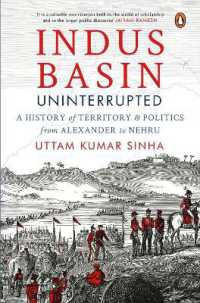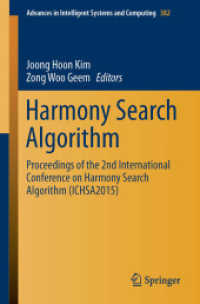Full Description
Covering a range of fundamental topics essential to modern forensic investigation, the fourth edition of the landmark text Forensic Science: An Introduction to Scientific and Investigative Techniques presents contributions from experts in the field who discuss case studies from their own personal files. This edition has been thoroughly updated to reflect the cutting edge of forensic science across many different areas. Designed for a single-term course at the lower undergraduate level, the book begins by discussing the intersection of law and forensic science, how things become evidence, and how courts decide if an item or testimony should be admissible. It takes the evidence from crime scene investigation into laboratory analysis and even onto the autopsy table for the fullest breadth of subject matter of any forensic text available. Topics include Forensic anthropology and the role of entomology in a death investigationDeath investigation, including identifying the cause, manner, mechanism, and time of deathBloodstain pattern analysis, the identification of blood and body fluids, the work of forensic toxicologists, and seized drug analysisThe history and development of DNA typing and the many ways it can be usedFingerprint, firearm and ballistic, tool mark, tread impression, and trace evidenceThe forensic analysis of questioned documents and computersArson, fire, explosives, and the work of forensic engineers in vehicular accidents and structural collapsesForensic psychology and psychiatry, including criminal profilingThe future of forensic science Going beyond theory to application, this text incorporates the wisdom of forensic practitioners who discuss the real cases they have investigated. Color-coded sidebars in each chapter provide historical notes, case studies, and current events as well as advice for career advancement. Each section and each chapter begins with an overview and ends with a summary, and key terms, review questions, and up-to-date references are provided. Appropriate for any sensibility, more than 300 photos from real cases give students a true-to-life learning experience. *Access to identical eBook version included
Contents
Setting the StageJustice and Science; Jon J. Nordby and Suzanne BellEvidence: Origins, Types, and Admissibility; Linda R. Netzel, Terrence F. Kiely, and Suzanne BellThe Crime SceneCrime Scene Investigation; Marilyn T. Miller and Patrick JonesBloodstain Patterns; Stuart H. James, Paul E. Kish, and T. Paulette SuttonForensic Death InvestigationDeath Investigation; Ronald K. WrightForensic Anthropology; William D. Haglund and Marcella H. SorgForensic Entomology; Gail S. AndersonForensic BiologyIdentification of Blood and Body Fluids; Andrew Greenfield, Monica M. Sloan, and Robert P. SpauldingDNA Typing; George Duncan, Martin Tracey, and Eric StaufferForensic ChemistryForensic Toxicology; John Joseph Fenton and Suzanne BellSeized Drug Analysis; Donnell R. Christian and Suzanne BellArson, Fire, and Explosives; David R. RedsickerPattern and Impression EvidenceFingerprints; R. E. GaensslenFirearms and Tool Marks; Walter K. RoweTread Impressions; William J. BodziakCross-Cutting Forensic DisciplinesTrace Evidence; Thomas A. Kubic and Nicholas PetracoQuestioned Documents; Howard Seiden and Frank NorwitchEngineering and ComputingForensic Engineering; Randall K. NoonForensic Computing; Zeno Geradts and Thomas A. JohnsonThe Human Element and the Future of Forensic ScienceBehavioral Science and Forensic Science; Kenneth P. Baker, Robert D. Keppel, Michael R. Napier, Robert L. Sadoff,and Louis B. SchlensingerThe Future of Forensic Science; Suzanne BellAppendicesIndex








